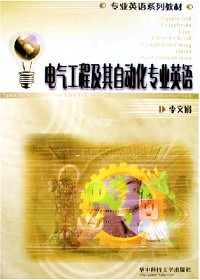
微信扫一扫,移动浏览光盘
简介
本书分为14个单元。主要内容包括电路、模拟电子技术、数字电子技术、电机学、自动控制、电气测量技术、电器设备、电力电子技术、电力系统等。书中内容是按每个单元用2学时授课的计划安排的,每个单元后都配有主要的词汇注释、要点注释和练习等内容,书后还给出了全部练习的参考答案。
本书既可作为电气工程及其自动化、工业电气自动化、自动控制、机电一体化等相关专业的专业英语教材,也可作为从事电子信息、自动化等相关专业工程技术人员的参考用书。
目录
1 basic concepts of electric circuits.
1.1 introduction
1.2 charge and current
1.3 voltage
1.4 power and energy
1.5 summary
2 basic laws of electric circuit
2.1 introduction
2.2 ohm's law
2.3 kirchhoffs laws
2.4 series resistors and voltage division
2.5 parallel resistors and current division
2.6 sununary
3 capacitors and inductors
3.1 introduction
3.2 capacitors
3.3 inductors
3.4 summary
4 electronic system
4.1 introduction
.4.2 electronic system block diagrams
4.3 information processing versus power electronics
4.4 analog versus digital systems
4.5 conversion of signals from analog to digital form
4.6 relative advantages of analog and digital systems
5 operational amplifiers
5.1 introduction
5.2 operational amplifiers
5.3 ideal op-amp
5.4 inverting amplifier
5.5 noninverting amplifier
5.6 summary
6 digital logic circuits
6.1 basic concepts
6.1.1 logic variables and digital words
6.1.2 the and gate
6.1.3 the logic inverter
6.1.4 the or gate
6.1.5 boolean algebra..
6.1.6 nand, nor, and xor gates
6.1. 7 logical sufficiency of nand gates and of nor gates
6.2 electrical specifications for logic gates
6.2.1 logic ranges
6.2.2 positive versus negative logic
6.2.3 input and output currents
7 transformer
7.1 introduction
7.2 construction of transformer
7.3 the ideal transformer
8 electrical machines
8.1 a brief overview
8.2 induction machines
8.2.1 introduction
8.2.2 induced voltages
8.3 synchronous machines
8.3.1 introduction
8.3.2 construction of synchronous machines
8.4 direct-current machines
8.4.1 introduction
8.4.2 armature voltage
9 automatic control systems
9.1 introduction
9.2 block diagrams and transfer functions
9.2.1 block diagrams
9.2.2 transfer functions
9.3 open-loop control
9.4 closed-loop control. feedback
9.5 objectives of a control system
10 measurement
10.1 introduction
10.2 statistics
10.3 operating characteristics
10.3.1 measurement
10.3.2 operation
10.4 static characteristics
10.5 velocity measurement
10.5.1 sensing methods
10.5.2 dc tachometers
10.5.3 ac tachometers
10.5.4 optical tachometers
11 switching components
11.1 introduction
11.2 mechanical switching components
11.2.1 mechanical switches
11.2.2 relays
11.2.3 time-delay relays
11.2.4 contactors and motor starters
11.3 solid-state components
11.3.1 diodes
11.3.2 transistors
11.3.3 silicon-controlled rectifiers
11.3.4 triacs
12 power semiconductor switches
12.1 introduction
12.2 thyristors
12.3 metal-oxide-semiconductor field effect transiswrs
12.4 gate turn-off thyristors
12.5 insulated gate bipolar transistors
12.6 desired characteristics in controllable switches
13 rectifiers and inverters
13.1 introduction
13.2 basic rectifier concepts
13.2.1 pure resistive load
13.2.2 inductance load
13.2.3 load with an internal dc voltage
13.3 practical thyristor converters
13.4 inverter mode of operation
14 basic knowledge of power systems
14. 1 introduction
14.2 electrical energy
14.3 fossil-fuel plant
14.4 nuclear power plant
14.5 hydroelectric power plant
14. 6 other energy sources
14.7 transmission and distribution systems
14.8 faults
14.9 system protection components
科技英语学习要点(二)
练习参考答案
参考文献..
1.1 introduction
1.2 charge and current
1.3 voltage
1.4 power and energy
1.5 summary
2 basic laws of electric circuit
2.1 introduction
2.2 ohm's law
2.3 kirchhoffs laws
2.4 series resistors and voltage division
2.5 parallel resistors and current division
2.6 sununary
3 capacitors and inductors
3.1 introduction
3.2 capacitors
3.3 inductors
3.4 summary
4 electronic system
4.1 introduction
.4.2 electronic system block diagrams
4.3 information processing versus power electronics
4.4 analog versus digital systems
4.5 conversion of signals from analog to digital form
4.6 relative advantages of analog and digital systems
5 operational amplifiers
5.1 introduction
5.2 operational amplifiers
5.3 ideal op-amp
5.4 inverting amplifier
5.5 noninverting amplifier
5.6 summary
6 digital logic circuits
6.1 basic concepts
6.1.1 logic variables and digital words
6.1.2 the and gate
6.1.3 the logic inverter
6.1.4 the or gate
6.1.5 boolean algebra..
6.1.6 nand, nor, and xor gates
6.1. 7 logical sufficiency of nand gates and of nor gates
6.2 electrical specifications for logic gates
6.2.1 logic ranges
6.2.2 positive versus negative logic
6.2.3 input and output currents
7 transformer
7.1 introduction
7.2 construction of transformer
7.3 the ideal transformer
8 electrical machines
8.1 a brief overview
8.2 induction machines
8.2.1 introduction
8.2.2 induced voltages
8.3 synchronous machines
8.3.1 introduction
8.3.2 construction of synchronous machines
8.4 direct-current machines
8.4.1 introduction
8.4.2 armature voltage
9 automatic control systems
9.1 introduction
9.2 block diagrams and transfer functions
9.2.1 block diagrams
9.2.2 transfer functions
9.3 open-loop control
9.4 closed-loop control. feedback
9.5 objectives of a control system
10 measurement
10.1 introduction
10.2 statistics
10.3 operating characteristics
10.3.1 measurement
10.3.2 operation
10.4 static characteristics
10.5 velocity measurement
10.5.1 sensing methods
10.5.2 dc tachometers
10.5.3 ac tachometers
10.5.4 optical tachometers
11 switching components
11.1 introduction
11.2 mechanical switching components
11.2.1 mechanical switches
11.2.2 relays
11.2.3 time-delay relays
11.2.4 contactors and motor starters
11.3 solid-state components
11.3.1 diodes
11.3.2 transistors
11.3.3 silicon-controlled rectifiers
11.3.4 triacs
12 power semiconductor switches
12.1 introduction
12.2 thyristors
12.3 metal-oxide-semiconductor field effect transiswrs
12.4 gate turn-off thyristors
12.5 insulated gate bipolar transistors
12.6 desired characteristics in controllable switches
13 rectifiers and inverters
13.1 introduction
13.2 basic rectifier concepts
13.2.1 pure resistive load
13.2.2 inductance load
13.2.3 load with an internal dc voltage
13.3 practical thyristor converters
13.4 inverter mode of operation
14 basic knowledge of power systems
14. 1 introduction
14.2 electrical energy
14.3 fossil-fuel plant
14.4 nuclear power plant
14.5 hydroelectric power plant
14. 6 other energy sources
14.7 transmission and distribution systems
14.8 faults
14.9 system protection components
科技英语学习要点(二)
练习参考答案
参考文献..
Special English for electrical engineering and automation
- 名称
- 类型
- 大小
光盘服务联系方式: 020-38250260 客服QQ:4006604884
云图客服:
用户发送的提问,这种方式就需要有位在线客服来回答用户的问题,这种 就属于对话式的,问题是这种提问是否需要用户登录才能提问
Video Player
×
Audio Player
×
pdf Player
×


